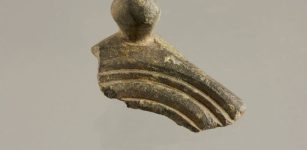Shinobi No Mono: The Shadow Warriors And Hattori ‘The Demon’ Hanzo Of Ancient Japan
Ellen Lloyd - AncientPages.com - Led by Hattori "the Demon" Hanzo, Shinobi no Mono, the Shadow Warriors of the 16th century were incredible ancient Japanese fighters who became known for their seemingly superhuman power and astonishing athletic accomplishments.
Credit: Adobe Stock - breakermaximus
The Shinobi Shadow Warriors were masters in becoming almost invisible through masterful stealth. One of their many helpful fighting skills was to avoid detection. Many credited these fighters with supernatural powers, and it was said that it was already too late to escape if you spotted a Shadow Warrior.
Today, the Shinobi no Mono and the Shadow Warriors are recognized as Ninjas.
In Japanese, the words "nin" and Wshinobi" have the same meaning: "stealth" or "quiet action." The words also mean "to endure." Meanwhile, "sha" and "mono" both mean "person." So a simple translation would be "a person skilled in the art of stealth."
In modern times, Ninjas are regarded as assassins, but historically, the Ninja played an entirely different role. Ninjas were often spies, scouts, and commando-type covert operation forces.
Credit: Adobe Stock - sheikoevgeniya
In 1562 A.D., Japan was a war-like zone. Ongoing civil wars that lasted more than 100 years devastated the country and its people.
Hattori' The Demon' Hanzo Of Ancient Japan
Tokugawa Ieyasu, an ambitious warlord, became the founder and first shogun of the Tokugawa shogunate of Japan, which virtually ruled Japan from the Battle of Sekigahara in 1600 until the Meiji Restoration in 1868.
Tokugawa Ieyasu used several skilled warriors to win battles and strengthen his military power. One of them was Hattori Hanzo (1542-1596), one of the greatest Ninjas of all time.
Hanzo Hattori began his training by climbing a mountain at eight and seeking instruction from the most hardcore ninja masters in Japan. When he was 16, he earned the nicknames "Hanzo the Ghost" and "Devil Hanzo" because of his skills to sneak up on enemies without being seen or heard.
Hanzo made a successful hostage rescue of Tokugawa's daughters in Kaminogo Castle in 1562 and went on to lay siege to Kakegawa Castle in 1569.
He became famous for unconventional warfare. He became the leader of the most elite fighting group in the Japanese world and trained his fighters in the secret martial art of Shinobi.
The Shadow Warriors And Their "Magical Powers"
The Shadow Warriors, trained by Hanzo Hattori, possessed magical powers. Hanzo himself was often attributed to supernatural abilities such as psychokinesis and precognition.
The shinobi, or ninja, is one of the most widely recognized figures in the world of espionage—and also one of the most misrepresented. What do we really know about the historical shinobi, his tactics, and his role in medieval Japanese society? In Secret Traditions of the Shinobi, these questions—and many more—are answered. Translated into English for the very first time, this widely sought-after collection of historical documents brings to light the secret practices, techniques, philosophies, and lifestyles of the shinobi. Read more
The Shinobi, or Ninja, is one of the most widely recognized figures in the world of espionage and one of the most misrepresented. What do we know about the historical Shinobi, his tactics, and his role in medieval Japanese society? In Secret Traditions of the Shinobi, these questions—and many more—are answered. Translated into English for the first time, this widely sought-after collection of historical documents brings to light the Shinobi's secret practices, techniques, philosophies, and lifestyles. Read more
The truth is that these warriors employed unusual military tactics. They could move undetected and vanish without a trace. It was one of the reasons why the Shadow Warriors were predominantly used for commando infiltration raids and information and intelligence gathering. They were considered ancient Japan's most effective resources for espionage.
Shinobi Warriors never infiltrated during the full moon due to the excessive light it reflects off the Sun during the nighttime hours. Instead, they preferred to enter either eight days before or after the full moon when optimal darkness was available. In this style of approach, the Ninja is nearly invisible in his black Shinobi gear.
A portrait of Hanzō Hattori from the 17th century. Unknown - Public Domain
After his death on 4 November 1596, Hattori Hanzo was succeeded by his son, whose name was also Masanari, though written with different kanji. He was given the title of Iwami no Kami, and his Iga Ninjas would act as guards of Edo Castle, the headquarters of the government of united Japan.
The memory of Hattori Hanzon is still very much alive. Tokyo Imperial Palace, which was earlier the shogun's palace, still has a gate called Hanzo's Gate (Hanzomon). The Hanzomon subway line from Hanzomon Station in central Tokyo to the southwestern suburbs is named after the entrance where his house was once located.
Updated on January 16, 2024
Written by Ellen Lloyd – AncientPages.com
Copyright © AncientPages.com All rights reserved. This material may not be published, broadcast, rewritten or redistributed in whole or part without the express written permission of AncientPages.com
Expand for referencesReferences:
Joel Levy - Ninja: The Shadow Warrior
More From Ancient Pages
-
 Neanderthals May Have Been Carnivores – New Study
Archaeology | Oct 17, 2022
Neanderthals May Have Been Carnivores – New Study
Archaeology | Oct 17, 2022 -
 Impressive Marble Statue Of A Ram, An Ancient Christian Symbol For Jesus Discovered
Ancient Symbols | Dec 28, 2015
Impressive Marble Statue Of A Ram, An Ancient Christian Symbol For Jesus Discovered
Ancient Symbols | Dec 28, 2015 -
 Sacred And Mysterious Lake Titicaca Still Holds Many Ancient Secrets
Ancient Mysteries | Jul 13, 2017
Sacred And Mysterious Lake Titicaca Still Holds Many Ancient Secrets
Ancient Mysteries | Jul 13, 2017 -
 Unsolved Ancient Mystery Of Lost Pre-Olmec Civilization – Evidence Of Advanced Scientific Knowledge That Could Re-Write History
Ancient Mysteries | Jul 16, 2018
Unsolved Ancient Mystery Of Lost Pre-Olmec Civilization – Evidence Of Advanced Scientific Knowledge That Could Re-Write History
Ancient Mysteries | Jul 16, 2018 -
 Piece Of Puzzling Roman Artifact Discovered In Belgium
Archaeology | Feb 16, 2023
Piece Of Puzzling Roman Artifact Discovered In Belgium
Archaeology | Feb 16, 2023 -
 Ancient Mammoth Ivory Carving Technology Of Master Craftsmen – Reconstructed
Archaeology | Aug 27, 2020
Ancient Mammoth Ivory Carving Technology Of Master Craftsmen – Reconstructed
Archaeology | Aug 27, 2020 -
 Ancient Greeks Had Great Understanding Of Weather And Climate
Civilizations | Sep 7, 2015
Ancient Greeks Had Great Understanding Of Weather And Climate
Civilizations | Sep 7, 2015 -
 Saraswati – Hindu Goddess Of Knowledge, Learning And Vedic Symbol Of Speech, Vach
Featured Stories | Jun 23, 2021
Saraswati – Hindu Goddess Of Knowledge, Learning And Vedic Symbol Of Speech, Vach
Featured Stories | Jun 23, 2021 -
 Nova Anglia: The Anglo-Saxon New England In The East
History | Jun 13, 2022
Nova Anglia: The Anglo-Saxon New England In The East
History | Jun 13, 2022 -
 Forgotten And Overgrown Step Pyramid Of Koh Ker – Ancient Memory Of The Khmer Empire
Featured Stories | Apr 19, 2017
Forgotten And Overgrown Step Pyramid Of Koh Ker – Ancient Memory Of The Khmer Empire
Featured Stories | Apr 19, 2017 -
 16 Meters Long Ancient Papyrus With Spells From The Book Of The Dead Found In Saqqara
Archaeology | Jan 19, 2023
16 Meters Long Ancient Papyrus With Spells From The Book Of The Dead Found In Saqqara
Archaeology | Jan 19, 2023 -
 Unusual 2,500-Year-Old Face Urns Reveal Garments, Appearance And Jewelry Of Prehistoric People
Archaeology | Nov 11, 2017
Unusual 2,500-Year-Old Face Urns Reveal Garments, Appearance And Jewelry Of Prehistoric People
Archaeology | Nov 11, 2017 -
 Sobekneferu: First Female Pharaoh In Ancient Egypt
Featured Stories | Mar 9, 2019
Sobekneferu: First Female Pharaoh In Ancient Egypt
Featured Stories | Mar 9, 2019 -
 Deformed Skulls And Clues Found In Ancient Cemetery In Hungary
Archaeology | May 1, 2020
Deformed Skulls And Clues Found In Ancient Cemetery In Hungary
Archaeology | May 1, 2020 -
 Sodré Astrolabe, Found On Portuguese Armada Shipwreck Is The Oldest In The World
Archaeology | Mar 19, 2019
Sodré Astrolabe, Found On Portuguese Armada Shipwreck Is The Oldest In The World
Archaeology | Mar 19, 2019 -
 New Models Shed Light On Life’s Origin
DNA | Feb 13, 2023
New Models Shed Light On Life’s Origin
DNA | Feb 13, 2023 -
 Why Is Africa Called Africa?
Ancient History Facts | Dec 1, 2020
Why Is Africa Called Africa?
Ancient History Facts | Dec 1, 2020 -
 On This Day In History: Mary Queen Of Scots Was Forced To Abdicate – On July 24, 1567
News | Jul 24, 2016
On This Day In History: Mary Queen Of Scots Was Forced To Abdicate – On July 24, 1567
News | Jul 24, 2016 -
 Sun Chariot – Powerful Symbol Of Bronze Age Cosmology
Ancient Symbols | Feb 28, 2018
Sun Chariot – Powerful Symbol Of Bronze Age Cosmology
Ancient Symbols | Feb 28, 2018 -
 Something Never-Before-Seen Is Hidden Beneath 15 Giant Viking Burial Mounds Spotted By Radar In Norway
Archaeology | Jan 19, 2021
Something Never-Before-Seen Is Hidden Beneath 15 Giant Viking Burial Mounds Spotted By Radar In Norway
Archaeology | Jan 19, 2021




